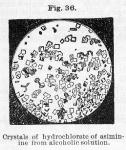 Related entry: Carica Papaya.—Papaw
Related entry: Carica Papaya.—Papaw
The seed of Asimina triloba, Dunal (Anona triloba, Linné; Orchidocarpum arietinum, Michaux; Porcelia triloba, Persoon; Uvaria triloba, Torrey and Gray).
Nat. Ord.—Anonaceae.
COMMON NAMES: Papaw, Pawpaw, Asiminer (Louisiana), American custardapple.
ILLUSTRATION: Lloyd's Drugs and Medicines of North America, Vol. II, plate xxxiii.
 Botanical Source.—This is a small and beautiful indigenous tree, growing from 10 to 20 feet high. The young shoots and expanding leaves are clothed with a rusty down, soon glabrous. The leaves are thin, smooth, entire, ovate-oblong, acuminate, 8 to 12 inches long, by 3 or 4 broad, tapering to very short petioles. The flowers are dull-purple, axillary, and solitary; the petals veiny, round-ovate, the outer ones orbicular, and three or four times as large as the calyx. The flowers appear early with the leaves (which are then small), and are about 1 ½ inch wide. The fruit is a yellowish, ovoid oblong, pulpy pod, 2 or 3 inches long by about 1 inch in diameter, fragrant, sweet, edible in autumn, and contains about 8 seeds (W.—G.).
Botanical Source.—This is a small and beautiful indigenous tree, growing from 10 to 20 feet high. The young shoots and expanding leaves are clothed with a rusty down, soon glabrous. The leaves are thin, smooth, entire, ovate-oblong, acuminate, 8 to 12 inches long, by 3 or 4 broad, tapering to very short petioles. The flowers are dull-purple, axillary, and solitary; the petals veiny, round-ovate, the outer ones orbicular, and three or four times as large as the calyx. The flowers appear early with the leaves (which are then small), and are about 1 ½ inch wide. The fruit is a yellowish, ovoid oblong, pulpy pod, 2 or 3 inches long by about 1 inch in diameter, fragrant, sweet, edible in autumn, and contains about 8 seeds (W.—G.).
History.—The papaw (sometimes improperly called the American custard-apple tree) is an inhabitant of the Middle, Southern, and Western States, growing in rich soil, and on the banks of streams, and flowering from March to June. The fruit is large and fleshy, and has an unpleasant odor, but when ripe and after frost, the pulp is sweet, luscious, and yellow, similar to custard; it is considered a healthy fruit, and is sedative and laxative. The seeds, which are the parts used, have a fetid odor, similar to stramonium; they are covered with a tough, hard, exterior coat, of a light-brownish color and smooth externally, lighter and wrinkled internally, inclosing a kernel of a whitish-yellow color, compressed, deeply fissured on both sides, nearly inodorous, very faintly bitter and sweetish, and dry and branny when chewed, leaving a very persistent, faint, but rather unpleasant sensation of nausea. They are of various shapes, being flat, ovoid, nearly circular, or somewhat reniform, with a longitudinal furrow or depression along the center of each of the flat surfaces, and frequently a ridge or elevation instead of the furrow. They yield their properties to alcohol. This fruit must not be confounded with the true papaw, from the Carica Papaya, an American tropical plant, whose fruit is the true custard-apple.
Chemical Composition.—The only chemical investigation of papaw seeds that we are aware of has been made by Prof. J. U. Lloyd, who isolated therefrom an alkaloid exhibiting anodyne properties, and to which he gave the name asiminine.It occurs as a white, tasteless, and colorless, amorphous alkaloid. In water it is practically insoluble, though it freely dissolves in alcohol and ether, and less readily in chloroform and benzol. Its soluble salts, and most of them are freely soluble in water, are bitter. Diluted alkalies precipitate the alkaloid from such solutions. The hydrochlorate, the salt most available for medicinal use, forms beautiful crystalline squares, or "interlocked sections of cubes," odorless, white, "at first sweetish, then bitter, leaving a bitter after-taste." Crystalline laminae are the forms assumed by the sulphate. Nitric acid strikes with it a carmine red, quickly changing to deep-black purple. The reaction is delicate, and should be differentiated from morphine, in that its color is not blood-red, and that it deepens to purple, and finally to dark red. It does not become lighter in color, nor does it turn yellow when treated with nitric acid. All parts of the asimina tree yield a fetid, volatile oil, and bitter extractive was obtained from the bark (see Lloyd's Drugs and Medicines of North America, Vol. II, pp. 54, 55).
Action, Uses, and Dosage.—Emetic, for which purpose a saturated tincture of the bruised seeds is employed, in doses of from 10 to 60 drops. The bark is said to be a bitter tonic, and has been used as such in domestic practice. The medical properties of this agent have not been fully investigated.

